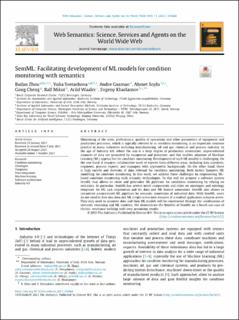| dc.contributor.author | Zhou, Baifan | |
| dc.contributor.author | Svetashova, Yulia | |
| dc.contributor.author | Silva Gusmao, Andre | |
| dc.contributor.author | Soylu, Ahmet | |
| dc.contributor.author | Cheng, Gong | |
| dc.contributor.author | Miku, Ralf | |
| dc.contributor.author | Waaler, Arild Torolv Søetorp | |
| dc.contributor.author | Kharlamov, Evgeny | |
| dc.date.accessioned | 2022-03-07T13:21:28Z | |
| dc.date.available | 2022-03-07T13:21:28Z | |
| dc.date.created | 2021-10-25T13:26:19Z | |
| dc.date.issued | 2021-10-22 | |
| dc.identifier.citation | Journal of Web Semantics. 2021, 71 1-21. | en_US |
| dc.identifier.issn | 1570-8268 | |
| dc.identifier.uri | https://hdl.handle.net/11250/2983458 | |
| dc.description.abstract | Monitoring of the state, performance, quality of operations and other parameters of equipment and production processes, which is typically referred to as condition monitoring, is an important common practice in many industries including manufacturing, oil and gas, chemical and process industry. In the age of Industry 4.0, where the aim is a deep degree of production automation, unprecedented amounts of data are generated by equipment and processes, and this enables adoption of Machine Learning (ML) approaches for condition monitoring. Development of such ML models is challenging. On the one hand, it requires collaborative work of experts from different areas, including data scientists, engineers, process experts, and managers with asymmetric backgrounds. On the other hand, there is high variety and diversity of data relevant for condition monitoring. Both factors hampers ML modelling for condition monitoring. In this work, we address these challenges by empowering ML-based condition monitoring with semantic technologies. To this end we propose a software system SemML that allows to reuse and generalise ML pipelines for conditions monitoring by relying on semantics. In particular, SemML has several novel components and relies on ontologies and ontology templates for ML task negotiation and for data and ML feature annotation. SemML also allows to instantiate parametrised ML pipelines by semantic annotation of industrial data. With SemML, users do not need to dive into data and ML scripts when new datasets of a studied application scenario arrive. They only need to annotate data and then ML models will be constructed through the combination of semantic reasoning and ML modules. We demonstrate the benefits of SemML on a Bosch use-case of electric resistance welding with very promising results. | en_US |
| dc.description.sponsorship | This work was partially supported by SIRIUS Centre, Norwegian Research Council project number 237898. | en_US |
| dc.language.iso | eng | en_US |
| dc.publisher | Elsevier | en_US |
| dc.relation.ispartofseries | Journal of Web Semantics;Volume 71, November 2021, 100664 | |
| dc.rights | Navngivelse 4.0 Internasjonal | * |
| dc.rights.uri | http://creativecommons.org/licenses/by/4.0/deed.no | * |
| dc.subject | Condition monitoring | en_US |
| dc.subject | Ontologies | en_US |
| dc.subject | Templates | en_US |
| dc.subject | Data integration | en_US |
| dc.subject | Machine learning | en_US |
| dc.subject | Software architecture | en_US |
| dc.title | SemML: Facilitating development of ML models for condition monitoring with semantics | en_US |
| dc.type | Peer reviewed | en_US |
| dc.type | Journal article | en_US |
| dc.description.version | publishedVersion | en_US |
| dc.rights.holder | © 2021 The Author(s) | en_US |
| cristin.ispublished | true | |
| cristin.fulltext | postprint | |
| cristin.qualitycode | 1 | |
| dc.identifier.doi | https://doi.org/10.1016/j.websem.2021.100664 | |
| dc.identifier.cristin | 1948246 | |
| dc.source.journal | Journal of Web Semantics | en_US |
| dc.source.volume | 71 | en_US |
| dc.source.pagenumber | 1-21 | en_US |
| dc.relation.project | Norges forskningsråd: 237898 | en_US |

